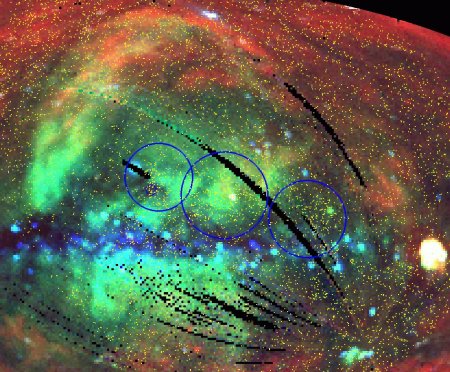
The constellation Scorpius the Scorpion is one of the few constellations that looks like its name. The red star Antares lies at the Scorpion’s Heart. Two “stinger” stars, Shaula and Lesath, mark the Scorpion’s Tail. Scorpius has another charming feature you should come to know. It’s called the Crown of the Scorpion.
Look for Scorpius as a J-shaped assemblage of stars arcing across the southern sky each summer as seen from the Northern Hemisphere – and crossing overhead in winter skies as seen from the Southern Hemisphere. The Scorpion’s Crown consists of three stars near Antares, which is the brightest star in Scorpius. Individually, the Crown stars are Graffias (or Acrab), Dschubba, and Pi Scorpii.

Scorpius is one of the few constellations that looks like its namesake. The bright red star Antares marks the Scorpion's Heart. The Crown of the Scorpion consists of three stars, located at the top of Scorpius to the right of Antares in this image.

The three stars of the Scorpion’s Crown: Graffias (Acrab), Dschubba, and Pi Scorpii. Photo by EarthSky Facebook friend Dennis Chabot. Thank you, Dennis.
It’s rare when star patterns on our sky’s dome have anything to do with real associations of stars in space, but these three stars are thought to be loosely bound by gravity. All three are located at approximately the same distance, about 500 light-years away. All are thought to be members of the Scorpius-Centaurus Association, which was first recognized by astronomers in the early part of this century.
About 100 stars are known in the Scorpius-Centaurus Association, including Antares.
The Scorpius-Centaurus stars share a common motion through space. They were probably all born from a single vast cloud of gas and dust. In other words, these stars are much like a family – loosely bound – sharing a common history.

Star map showing the Scorpius-Centaurus Association. The stars of upper Scorpius are part of this association of stars in space. Read more at Wikimedia Commons.

Wide field X-ray image of the Scorpius-Centaurus association constructed from the data of the ROSAT All Sky Survey Background maps. The yellow dots mark the positions of bright X-ray sources detected in the survey (only about 10% of the brightest X-ray sources are shown). The blue circles mark the three subgroups Upper Scorpius, Upper Centaurus-Lupus, and Lower Centaurus-Crux (from left to right). Image and caption via David Darling.
Bottom line: One of the most prominent features in the constellation Scorpius is a trio of stars near Antares on the sky’s dome. These three stars – Graffias, Dschubba and Pi Scorpii – are known as the Crown of the Scorpion.

















